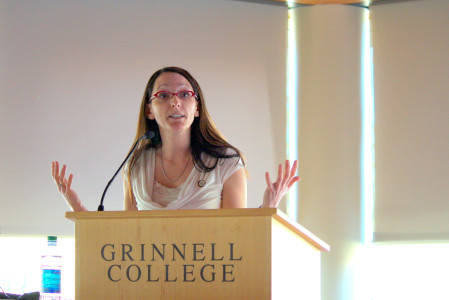Jessi Smith, a psychology professor at Montana State University, addressed the different aspects of gender diversity and discrimination issues in science, technology, engineering and mathematics (STEM) fields in front of a packed audience in JRC 101 for her convocation speech on Wednesday, April 1. Smith’s speech, which was titled, “Changing the Face of Science: How to Create a More Diverse and Inclusive STEM Community,” touched on the implicit biases and stereotypes that many current and future academics hold, and explained how those sentiments result in the wide gap between the number of men and women in those areas of academia. Her talk was co-sponsored by the Scholars’ Convocation Committee, the Office of Diversity and Inclusion and the Howard Hughes Medical Institute Grant.
Smith was introduced by Professor Mark Levandoski, Chemistry, who had recommended her to the College via the Scholars’ Convocation Committee.
“Her research in the STEM community seemed to be intriguing to students, she has done extensive research on gender discrimination, and so the committee selected [Smith] approximately a year ago,” said Special Programming Coordinator Teresa McCall.
Smith began her presentation with a slideshow of images that reflect common biases concerning the STEM fields and gender lines, explaining that seemingly harmless images reinforce stereotypical perceptions of who can and cannot be successful in STEM.
“These images get perpetuated in our culture and can send very subtle messages about what is valued and who is valued,” Smith said.
Her presentation continued with a breakdown of STEM faculty by department, with Smith noting that biology faculty are at parity with approximately 53 percent of the jobs in the field being held by women, but that overall women are still significantly underrepresented as faculty in the STEM community. Smith also pointed out that those discrepancies persisted in regards to the gap between the hiring of male and female faculty at Grinnell as well.
“Thirty-four percent of STEM faculty nationwide are women. Grinnell has 36 percent tenure-track faculty who are women,” she noted. “One department contains the majority of women in STEM: psychology. Excluding that field drops the percentage of women faculty to 29 percent.”
These efforts however, Smith pointed out, are much easier said than done. She explained how hiring managers often look for employees with stereotypically male traits, such as never taking time off for caregiving, or having a partner at home to support them. Smith also cited a study published in the academic journal “Proceedings of the National Academy of Sciences,” which showed that science faculty have subtle gender biases that favor male students, even despite the faculty members’ self-perceived rationality in deciding hire-ability and starting salary.
In regards to the common perceptions of STEM fields, Smith addressed how stereotypes of that academic community as lonely and solitary academic work hurt men, women and the community at large.

“There’s a stereotype that you have to be brilliant at STEM. It’s a stereotype. That’s not true. But people make their major decisions on that stereotype,” Smith said. “Women and minority students especially say that they prefer jobs that have meaning and have significance where they can give back to the community, and STEM often rates very low in those ‘communal values.’”
She acknowledged that these damaging stereotypes are usually very difficult to break, as they are the result of many years of both subtle and blatant reinforcement and are extremely widespread.
“This is called implicit bias. Knowing about implicit bias is definitely a first step,” she said. “But there’s a disconnect between knowing that it’s there and finding the way that it influences you. Both men and women show unconscious gender biases, because it’s internalized by everyone.”
Subsequently, Smith argued that diversity in both background and perspectives results in better outcomes and more creative problem-solving. She pointed to Montana State’s own diversity initiative, called ADVANCE Project TRACS, which seeks to make the school more gender equitable, and resulted in 50 percent female faculty hires between 2012 and 2013. Smith outlined how the school became more gender equitable for faculty and students alike through the creation of inclusive spaces, emphasizing effort over talent and focusing on work-life integration.
“Even though we’re targeting women in STEM, we hope that everybody will experience a positive change over time,” Smith said. “There’s a contagious effect to this work.”



















































